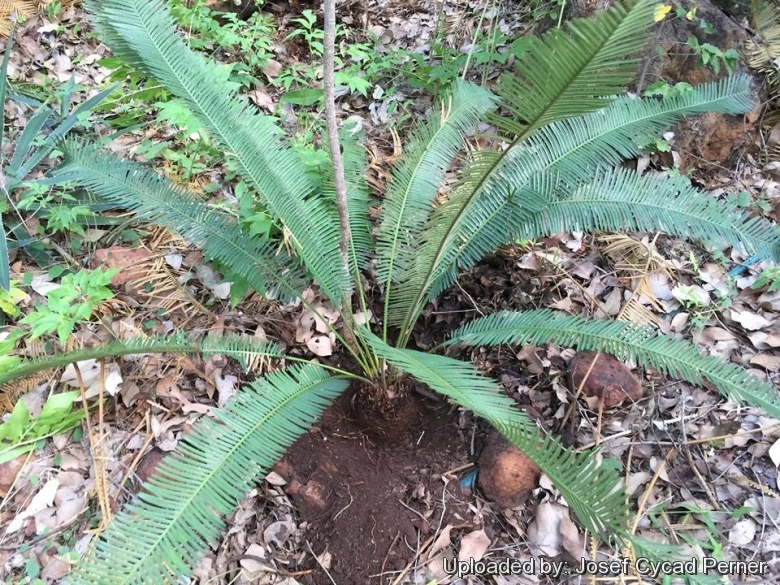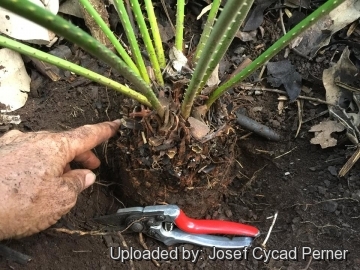
Cycas arnhemica Photo by: Josef Cycad Perner
Origin and Habitat: This species occurs in the Northen Territory of Australia. Populations are found only around the Goyder River and the lower Blyth River in Arnhem land, it has a somewhate restricted distribution. It is locally abundant with population size of at least 10,000 plants and there seems to be little or no decline.
Habitat and ecology: This cycad, like Cycas arenicola, is an understorey plant common amongst the Eucalyptus tetrodonta - Eucalyptus miniata woodlands and savanna grasslands on deep white to yellow sands over laterites. This cycad is both rare and has commercial potential at least partly because of its rarity. Annual grass fires kills seed and seedlings, but it is not yet seen as a threat. However, the conservation status is considered stable due to its inhospitable habitat and healthy number of individuals.
Synonyms:
See all synonyms of Cycas arnhemica
Description: Cycas arnhemica is a species of cycad in the genus Cycas first described in 1994, it is most closely related to Cycas maconochiei.
Derivation of specific name: From its occurrence in central Arnhem Land in the northwest of Northern Territory.
Trunks: Erect, up to 1.5-2.5 m tall.
Leaves: Flat, 70-160 cm long, pinnate, with 160-260 leaflets; the new young leaves are deep white tomentose at first, becoming bright to dark green, moderately glossy above, the down often persisting on the underside.
Megasporophylls: Like other Cycas species, the female plants do not bear cones; instead they carry ovules and seeds on open, 15–24 cm long, grey leaf-like megasporophylls, clothed with grey and orange hairs. Ovules 2-6 per sporophyll. Triangular lamina, toothed, with an apical spine.
Male cones: Solitary, ovoid, 18–36 cm long and 6.5–12 cm diameter, also covered in orange hairs.
Seeds : 28–32 mm long and 25–29 mm broad, with an orange sarcotesta when ripe.
Subspecies, varieties, forms and cultivars of plants belonging to the Cycas arnhemica group
 Cycas arnhemica K.D.Hill: has longer leaves with broader and more widely spaced leaflets, 5-6.5 mm wide and distinctly angled towards the leaf apex. Distribution: around the Goyder river in central to eastern Arnhem Land.
Cycas arnhemica K.D.Hill: has longer leaves with broader and more widely spaced leaflets, 5-6.5 mm wide and distinctly angled towards the leaf apex. Distribution: around the Goyder river in central to eastern Arnhem Land.- Cycas arnhemica subs. muninga Chirgwin & K.D.Hill: has larger cones and seeds over 32 mm wide. Leaves crowded and numerous. Leaflets slender, 3.5-5.5 mm wide and more or less perpendicular to the rachis. Distribution: known only from Groote Eylandt in the Gulf of Carpentaria.
- Cycas arnhemica subs. natja K.D.Hill: has smaller cones and seeds under 32 mm wide. Leaflets slender, 3.5-5.5 mm wide and more or less perpendicular to the rachis. Distribution: north coast of Arnhem Land (lower Blyth River to Elcho Island).
Bibliography: Major references and further lectures
1) Griffiths A.D. Schult H.J. and Gonnan J. “Wild harvest of Cycas arnhemica (Cycadaceae): impact on survival, recruitment and growth in Arnhem Land, northern Australia”. Australian Journal of Botany 53:771-779. 2005
2) Wikipedia contributors. "Cycas arnhemica." Wikipedia, The Free Encyclopedia. Wikipedia, The Free Encyclopedia, 3 May. 2015. Web. 22 Feb. 2016.
3) The Cycad Pages “Cycas arnhemica” Royal Botanic Gardens Sydney Written and maintained by Ken Hill 1998-2010 Maintained by Leonie Stanberg and Dennis Stevenson 2010-2012 <http://plantnet.rbgsyd.nsw.gov.au/cgi-bin/cycadpg?taxname=Cycas+arnhemica> Web. 22 Feb. 2016.
4) Hill, K.D. 2010. Cycas arnhemica ssp. arnhemica. The IUCN Red List of Threatened Species 2010: e.T42028A10631085. http://dx.doi.org/10.2305/IUCN.UK.2010-3.RLTS.T42028A10631085.en. Downloaded on 22 February 2016.
5) Hill, K.D. from "Palms & Cycads" No. 43, Apr-Jun 1994
 Cycas arnhemica Photo by: Josef Cycad Perner
Cycas arnhemica Photo by: Josef Cycad PernerSend a photo of this plant.The gallery now contains thousands of pictures, however it is possible to do even more. We are, of course, seeking photos of species not yet shown in the gallery but not only that, we are also looking for better pictures than those already present.
Read More... Cultivation and Propagation: Cycas arnhemicaSN|32543]]SN|32543]] is suited to tropical regions which have a seasonally dry climate. It is easy to grow, tolerating dry periods. It makes a beautiful ornamental for tropical and some warm temperate areas but is rather rare in cultivation.
Growth rate: Usually slow growing, however good conditions can speed it up considerably. Because of its growth habit, fertilize only when terminal bud begins to swell, indicating the start of the annual growth cycle.
Exposure: It prefers bright light exposure but colour bleaches when in full sun; best with some protection from afternoon heat.
Soil: Needs a well drained spot, with deep soil, but will still thrive in less than ideal conditions.
Maintenance: Minimal; removal of offsets if desired, removal of spent fronds.
Use: Landscape as cultivated perennial in warm, coastal areas; House-plant or interior-scape, as container plant in cool areas, as well very well suited to bonsai culture.
Propagation: Seed. After fertile seeds are collected, they usually need several months of storage before the inner embryo is ready to germinate. Therefore, it is best to clean the seeds of external fruit and set them aside before attempting to propagate the seeds.










